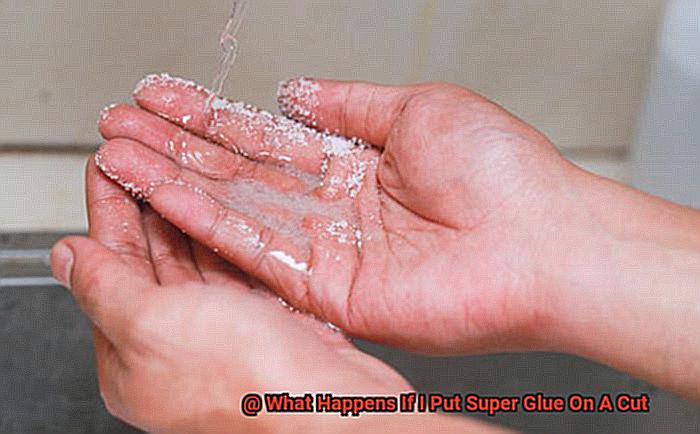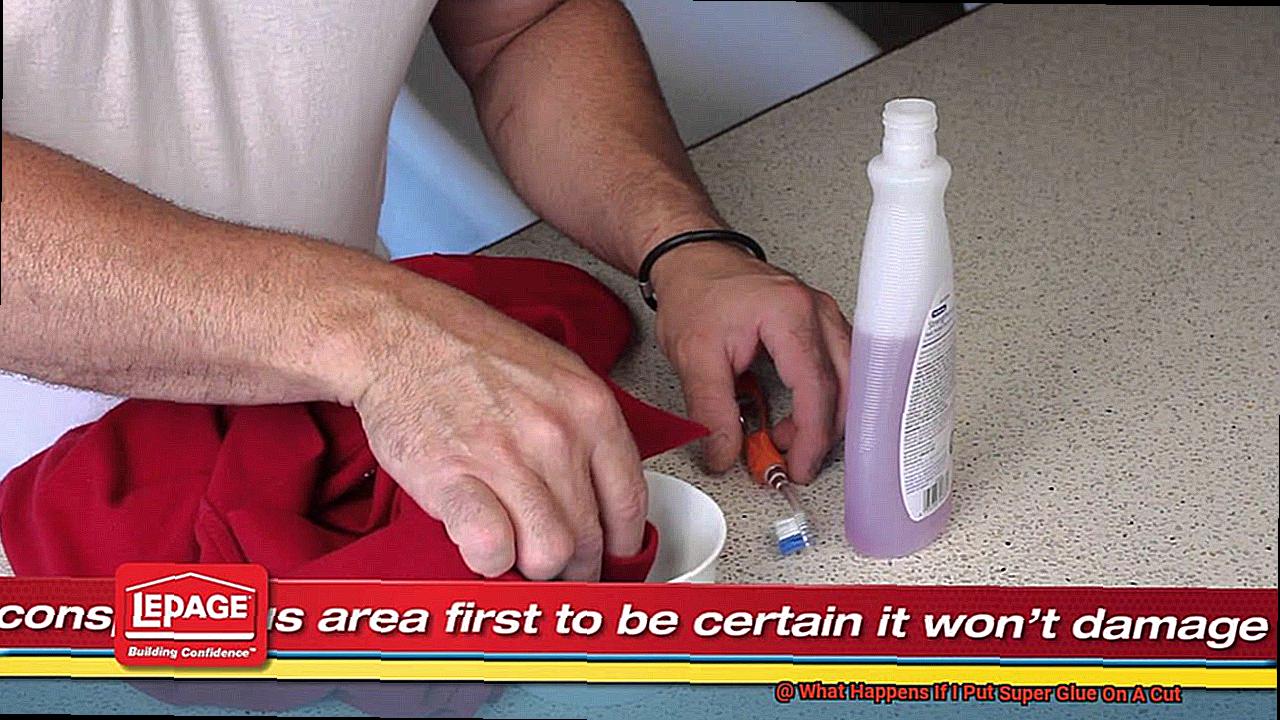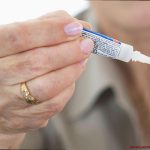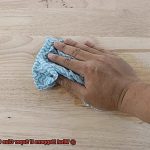Picture this: you’re going about your day, when suddenly, a cut appears out of nowhere. Ouch. Your first instinct is to find a quick fix to seal up that wound and keep it protected. That’s when the thought crosses your mind – why not use super glue? It’s fast, it’s adhesive, but is it safe and effective?
In this blog post, we’re diving deep into the potential consequences of using super glue on a cut. We’ll explore the risks and benefits, giving you all the information you need to make an informed decision in those moments of need.
The whole point of using any adhesive on a wound is to help it heal while reducing the risk of infection. Super glue might seem like a tempting option with its rapid drying and sticking power, but let’s uncover why it may not be the best idea.
Super glue was designed for fixing non-living things, not for direct application on cuts. In the following paragraphs, we’ll break down exactly why using super glue on a cut can lead to some seriously undesirable outcomes.
- Toxicity: Super glue contains chemicals called cyanoacrylates that can release toxic fumes when they come into contact with bodily fluids. These fumes can cause irritation or even respiratory problems – definitely not what you want when trying to heal a cut.
- Delayed Healing: Sure, super glue can create an unbreakable bond between objects, but wounds require a different approach. When applied directly to cuts, super glue can irritate tissues and cause inflammation that hampers normal cell growth and migration – slowing down the healing process.
- Potential Infection: Super glue forms a protective seal over the wound, which may sound great at first glance. But here’s the catch – without proper airflow and drainage, it becomes difficult to assess the healing progress or spot signs of infection. This sealed environment can become a breeding ground for bacteria, leading to even more serious complications.

On the flip side, using appropriate wound closure methods like sterile adhesive strips or medical-grade skin adhesive offers a safer alternative. These products are specifically designed for wound closure, promoting proper healing, reducing infection risks, and allowing for regular monitoring of the wound’s progress.
While super glue may seem like a quick fix, it’s not recommended for cuts due to its potential toxicity, delayed healing effects, and increased risk of infections. When faced
What is Super Glue?
Contents
Super Glue, known scientifically as cyanoacrylate adhesive, is a remarkable invention that has revolutionized the way we bond materials together. Its quick setting time and exceptional strength make it an indispensable tool in various industries and everyday applications. In this comprehensive guide, we will explore the fascinating characteristics, diverse uses, and rich history of Super Glue.
Rapid Bonding and Unyielding Strength:
At the heart of Super Glue lies its ability to set in mere seconds, providing an almost magical instant adhesion. This feature makes it ideal for quick fixes and precise positioning of small objects. Furthermore, despite its lightning-fast bonding process, Super Glue forms an incredibly robust bond capable of withstanding significant stress.
Versatility in Material Compatibility:
Super Glue is a versatile adhesive that can bond a wide range of materials with ease. Whether you’re working with plastics, metals, ceramics, rubber, leather, or even some fabrics, Super Glue ensures a reliable and durable connection. It boasts exceptional adhesion to most surfaces, making it a go-to adhesive for countless projects.
Tailored Formulations for Every Need:
Super Glue comes in various formulations designed to cater to specific requirements. If you desire a transparent finish, there are formulations that dry completely clear. On the other hand, if flexibility is paramount for your bond, flexible versions are readily available. Gel formulas offer excellent control when working with vertical surfaces or filling gaps. These specialized variations provide users with options tailored to their unique projects.
A Brief History:
Super Glue’s journey began in 1942 when Dr. Harry Coover developed it while working for Eastman Kodak Company. Originally intended for use as a transparent plastic gun sight during World War II, its adhesive properties were soon recognized and commercialized in 195Since then, Super Glue has become a household name and an essential tool in various industries around the world.
Potential Risks of Using Super Glue on a Cut
We’ve all experienced that heart-dropping moment when a harmless activity turns into a painful mishap. Cuts and wounds are an unfortunate part of life, but before you reach for that trusty tube of Super Glue, let’s explore the potential risks of using it to mend your wounds.
Increased Risk of Infection:
Super Glue is not designed for wounds, and its lack of sterility poses a significant risk. When applied to a cut, the chemicals in Super Glue can introduce unwanted bacteria, increasing the chances of infection. It’s like inviting an army of microscopic invaders to the party.
Interference with Wound Healing:
While Super Glue may initially staunch bleeding and create a barrier against dirt and bacteria, it can hinder the natural healing process. The hardened plastic-like layer it forms may prevent the wound from closing properly, leading to delayed healing. It’s like building a wall instead of allowing your body to heal itself.
Skin Irritation and Allergic Reactions:
Some unlucky souls may experience skin irritation or allergic reactions when exposed to Super Glue. Applying it directly on a cut can further aggravate the surrounding skin and potentially worsen existing skin conditions. It’s like pouring gasoline on a fire.
Heat Production and Tissue Damage:
Super Glue generates heat when it encounters moisture like blood. If applied in large quantities or on deep cuts, this heat can cause burns or tissue damage, adding injury to insult. It’s like playing with fire and expecting not to get burned.
Difficulty in Removal:
Super Glue’s fast-acting and strong bonding properties make it challenging to remove once applied to a wound. This can impede healthcare professionals from adequately cleaning and treating the wound if necessary. It’s like getting stuck in quicksand while trying to save yourself.
The Effect of Super Glue on the Healing Process
Benefits:
- Seals the Wound: The primary benefit of using super glue on cuts is its ability to create a barrier or seal over the wound. This can be particularly useful for small, superficial cuts that don’t require stitches or medical intervention. By sealing the wound, super glue prevents bacteria or dirt from entering the site, reducing the risk of infection.
- Promotes Faster Healing: Super glue forms a strong bond when it comes into contact with moisture, including the moisture present on our skin. When applied to a cut, it quickly reacts with the wound’s moisture and hardens, creating a protective layer. This protective layer keeps the wound clean and acts as a barrier against friction and movement, allowing the cut to heal undisturbed.
Risks:
- Allergic Reactions: One significant risk associated with using super glue on cuts is the potential for allergic reactions. Some individuals may be hypersensitive or allergic to the chemicals present in super glue, leading to skin irritation, redness, swelling, or even more severe allergic reactions. It’s essential to be aware of any potential allergies before using super glue on a cut.
- Trapping Bacteria or Foreign Substances: Another risk is the potential for trapping bacteria or foreign substances beneath the super glue. If there are any contaminants present in the wound at the time of application, sealing them under the glue could lead to infection or other complications. It is crucial to clean the wound thoroughly before applying super glue.
- Lack of Flexibility: Super glue is not flexible and can become brittle over time. As the wound begins to heal and the skin expands or moves, the hardened glue may crack or break, causing discomfort or delaying the healing process.
- Not Suitable for Deep Wounds: It is important to note that super glue should never be used on deep or serious wounds that require medical attention. Deep cuts may require stitches, professional wound care, or other medical interventions to ensure proper healing and reduce the risk of infection.
Alternatives to Using Super Glue
When faced with a small cut or wound, it’s natural to reach for the nearest super glue. But did you know there are safer alternatives that can provide better protection and promote proper healing? In this article, we’ll explore various options for wound closure that go beyond the quick fix of super glue.
Adhesive Bandages and Medical Tape:
Adhesive bandages and medical tape are tried and true options for wound closure. Designed to create a protective barrier, they shield the wound from bacteria and dirt. With a variety of sizes and shapes available, you can find the perfect fit for your cut or wound. Not only do they seal the wound effectively, but they also allow for flexibility and movement, ensuring comfort during the healing process.
Liquid Bandages:
Liquid bandages offer a modern alternative by forming a protective barrier over the wound. Applied as a liquid, these bandages dry quickly to create a flexible film that keeps out bacteria and debris while allowing the wound to breathe. They are particularly useful for cuts in areas prone to movement, such as joints or fingertips.
Steri-strips or Butterfly Closures:
For small cuts that require more support, consider using steri-strips or butterfly closures. These adhesive strips are applied across the cut, holding the edges of the wound together. By providing stability, they promote proper healing by keeping the wound closed. Steri-strips are often used as an alternative to stitches in minor lacerations.
Medical-Grade Cyanoacrylate Adhesive:
In certain situations, medical professionals may recommend using medical-grade cyanoacrylate adhesive instead of super glue. These adhesives are specifically formulated for medical use, ensuring safety and effectiveness in wound closure. When traditional methods of closure are not available, they provide a strong bond without the risks associated with regular super glue.
How to Properly Clean and Close a Wound
Today, we embark on a journey into the world of wound care. Have you ever wondered how to properly clean and close a wound? Well, today is your lucky day. We will guide you through this essential process and explain why using super glue is a major mistake.
Wash Those Hands.
Before we delve into the intricacies of wound cleaning, let’s start with the basics. Always remember to wash your hands thoroughly with soap and water before touching any cuts or scrapes. Clean hands equal happy wounds.
Gentle Rinsing and Patting Dry
When it comes to cleaning a wound, imagine yourself as a gentle summer breeze. Rinse the wound with clean water or sterile saline solution to remove dirt and debris. Remember, no rubbing allowed. After rinsing, pat the wound dry with a clean towel or gauze pad, ensuring not to aggravate the area.
Adieu, Bleeding.
If your wound is bleeding like a leaky faucet, fear not. Apply gentle pressure using a clean cloth or sterile gauze pad until it stops. Remember, slow and steady wins the race when it comes to stopping the flow.
The Power of Adhesive Strips
For small wounds that aren’t too deep, adhesive strips are your go-to heroes. They act as tiny superheroes that keep the edges of the wound together, promoting faster healing. Ensure they aren’t too tight or uncomfortable, providing just the right support.
Keep It Covered
After applying adhesive strips, cover your wound with a sterile dressing or bandage. This protective layer shields it from pesky germs and further contamination. Remember to change the dressing regularly and be vigilant for signs of infection such as redness, swelling, pain, or discharge.
Don’t be Tempted by Super Glue
Ah, super glue – the magical fixer of almost anything. But when it comes to cuts, it’s a big no-no. Super glue contains irritating chemicals that can hinder healing and harm your skin. Save the super glue for fixing broken toys and avoid it like the plague when it comes to wounds.
You now possess the knowledge to properly clean and close a wound. Remember to wash your hands, rinse gently, use adhesive strips, and keep it covered. And most importantly, say no to super glue. If you’re ever uncertain about what to do, seek guidance from a healthcare professional. Stay safe, stay healthy, and keep those wounds happy.
When to Seek Medical Attention for a Cut
Imagine going about your day when suddenly, you find yourself with a cut. It’s a common type of injury that can happen to anyone, but how do you know when it’s necessary to seek medical attention? Don’t worry, we’ve got you covered with all the information you need.
First and foremost, let’s talk about the severity of the cut. If it’s just a minor cut that’s shallow and not too long, you can usually take care of it at home with some basic first aid. Clean the wound with mild soap and water, apply an antiseptic ointment, and cover it with a sterile bandage. However, if the cut is deep, gaping, or longer than an inch, it’s time to head to the doctor. These types of cuts may require stitches to ensure proper healing and minimize scarring.
Next, let’s consider the location of the cut. If it’s on a sensitive area of your body, like your face, hands, or genitals, you should definitely seek medical attention. These areas have a higher risk of infection and may require special care from a healthcare professional.
Now, what if the cut was caused by a dirty or rusty object? That’s another red flag for seeking medical attention. There’s a risk of tetanus infection, which needs prompt medical treatment. Tetanus is a serious bacterial infection that affects the nervous system and can cause muscle stiffness and spasms. A tetanus shot or tetanus immune globulin may be necessary to prevent complications.
Speaking of infections, if you notice any signs like redness, swelling, warmth, pus-like drainage, or increasing pain around the cut, don’t hesitate – seek medical attention right away. These are all indications that an infection may be developing and requires medical intervention.
If the cut was caused by a human or animal bite, it’s important to see a doctor as well. These types of wounds are prone to infection due to the bacteria present in the mouth. A healthcare professional may prescribe antibiotics to prevent or treat an infection.
People with underlying health conditions like diabetes or compromised immune systems should also seek medical attention for even minor cuts. Their bodies may have difficulty fighting off infections, and a healthcare professional can provide appropriate care and monitor the wound closely to prevent complications.
Last but not least, excessive bleeding that doesn’t stop with direct pressure or if there’s an object embedded in the cut – immediate medical attention is a must. Excessive bleeding may indicate damage to blood vessels or an underlying medical condition that needs urgent treatment. An embedded object can cause further damage or introduce foreign bacteria into the wound.
Specialized Tools and Techniques for Wound Care
When it comes to wound care, specialized tools and techniques are essential for effective treatment and promoting healing. From cutting away dead tissue to securing dressings in place, these tools play a crucial role in ensuring proper wound management. One particularly useful tool in wound care is medical-grade glue, also known as tissue adhesive. Let’s explore some of the specialized tools and techniques used in wound care, with a focus on glue.
To begin, sterile scissors or sharp medical scissors are indispensable in wound care. These specially designed scissors are used to precisely cut away dead skin or tissue surrounding the wound. By removing any barriers to new tissue growth, these scissors promote healing and minimize the risk of infection.
In addition to scissors, sterile tweezers or forceps are essential tools for wound care. They allow healthcare professionals to delicately remove debris, such as dirt or foreign objects, from the wound site. This process not only prevents infection but also aids in the healing process.
A wound irrigation system is another specialized tool that plays a vital role in wound care. This device utilizes a steady stream of sterile saline solution to thoroughly clean the wound and remove any bacteria or contaminants. By creating an optimal environment for healing, this technique ensures that the wound heals properly and quickly.
Once the wound is clean, a sterile dressing or bandage is applied. These dressings act as a protective barrier between the wound and the external environment, preventing further contamination and promoting healing. Adhesive medical tapes are used to secure these dressings in place. It is crucial that these tapes are hypoallergenic and gentle on the skin to avoid causing any additional irritation.
In some cases, healthcare professionals may perform wound debridement. This technique involves removing dead or infected tissue from the wound bed. By creating a clean and healthy environment for new tissue growth, wound debridement promotes faster healing and reduces the risk of complications.
When it comes to closing wounds, various techniques may be employed. Sutures, staples, adhesive strips, or tissue adhesives, such as medical-grade glue, can be used depending on the severity and location of the wound. These techniques bring the edges of the wound together, facilitating healing and minimizing scarring.
For more complex wounds that require advanced treatment, specialized tools like negative pressure wound therapy devices can be utilized. These devices create a vacuum-like environment around the wound, promoting blood flow, reducing swelling, and facilitating faster healing.
Also Read: Can You Super Glue Electrical Wires?
Conclusion
Putting super glue on a cut may seem like a quick fix, but it’s important to understand the potential consequences.
While super glue can create a temporary seal and stop bleeding, it is not designed for medical use. The chemicals in super glue can cause irritation, burning sensations, and even tissue damage.
Furthermore, using super glue on a deep or infected wound can trap bacteria inside, leading to infection. It’s always best to clean the wound thoroughly with mild soap and water, apply an antibiotic ointment, and cover it with a sterile bandage.
If the cut is severe or doesn’t stop bleeding, seek medical attention immediately.






